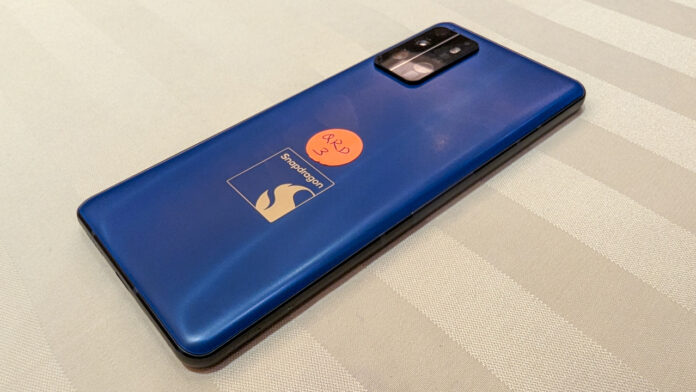Qualcomm knows that flashy slide presentations and executive testimonials only go so far when it comes time to talk about the real-world performance of its processors. That’s why it offered attendees of its recent Snapdragon Summit the opportunity to run some benchmarks on a reference device it built around the Snapdragon 8 Gen 2 system-on-a-chip. The results prove that Qualcomm is able to deliver meaningful gains year over year, though there are some caveats.
Reference Hardware
Before we get into the nitty-gritty of the results, let’s talk quickly about the smartphone used for testing. Qualcomm created a reference device with what we’d call average, but not quite top-of-the-line, flagship specs.
(Credit: Eric Zeman)
The smartphone in question has a large screen with Full HD+ resolution (2,400 x 1,080 pixels) and a 144Hz refresh rate. It’s powered by the Snapdragon 8 Gen 2 with 12GB of RAM and 256GB of storage. Qualcomm didn’t specify whether the RAM is LPDDR4x or LPDDR5x (the latter of which is faster), nor did it specify if the storage was UFS 3.1 or UFS 4.0 (again, the latter of which is faster).
The reference hardware was running a 64-bit version of Android 13 with OpenGL ES 3.2 and Vulkan 1.3 along with an Adreno 740 GPU. Other specs include a 3,550mAh battery, a 12.9MP rear camera, a 15MP front camera, a fingerprint reader, and so on. These latter components don’t really play a role in benchmarking, but we listed them for the sake of thoroughness.
The biggest caveat to make with respect to benchmarking this reference hardware is thermals. Performance degrades when temperatures go up. Most of the benchmarking PCMag completes is done at room temperature. The benchmarking room was slightly warmer than what we’d call room temperature, though we don’t have an exact reading.
More importantly, the reference phones were not allowed to rest or cool down between test runs. Qualcomm limited time on-site with the reference devices and that necessitated running the tests one after the other. Normally, we’d allow devices to return to room temperature before running subsequent tests. In one run of 3DMark, we noted that the CPU temperature reached 107.6 degrees Fahrenheit, which is fairly hot for a CPU. In other words, the results here could all have been better.
Better Than 8 Gen 1 and Tensor G2
There’s no question the 8 Gen 2 benchmark results rank higher than those generated by last year’s 8 Gen 1 and Google’s new Tensor G2 across a number of tests.
The 3DMark Wildlife Extreme test, for example, which really pushes the GPU, showed a score of 3,769 on the reference device. The Google Pixel 7 Pro, by way of comparison, reached only 1,823 on the same test while the Apple iPhone 14 Pro Max topped out at 3,377.
3DMark results
(Credit: Eric Zeman)
Geekbench 5 showed marked improvement year over year compared to the 8 Gen 1. The reference phone hit 1,489 on the single-core test and 5,178 on the multi-core test. The 8 Gen 1-powered Galaxy G22+ hit 1,216 and 3,448 on those same tests, respectively. That’s a solid jump for both tests. The Tensor G2-powered Pixel 7 Pro hit only 1,050 and 3,190 on Geekbench 5.
Geekbench 5 results
(Credit: Eric Zeman)
Then there’s a test like AnTuTu. This is a long test that covers every aspect of performance. The reference phone reached a higher score than I’ve ever seen before of 1,282,795. That’s a huge leap from the 927,796 score of the 8 Gen 1 on the Samsung Galaxy S22 Ultra. It’s also better than the 945,794 reached by the Apple iPhone 14 Pro Max, and the 740,510 of the Pixel 7 Pro.
AnTuTu results
(Credit: Eric Zeman)
On the PCMark test, the reference device scored 18,633, which beats the 11,363 of the Pixel 7 Pro and the 13,974 of the Galaxy S22+. Last, we ran GFXBench’s Aztec Ruins tests, where the reference phone scored 65fps versus the Pixel 7 Pro’s 25fps and the Galaxy S22+’s 29fps. Here, the 8 Gen 2 achieved more than double the number of frames per second.
Strong Early Impressions
While this first batch of testing shows promise, it’s important to remember that every phone maker will implement the Snapdragon 8 Gen 2 in its own way with its own software and customizations. Moreover, some 8 Gen 2 phones will have less RAM while others will have more. Screen sizes, resolutions, and refresh rates will play a role, too.
Even so, the 8 Gen 2 proves that Moore’s Law isn’t quite dead yet. What will be more exciting to watch, however, is not how fast 8 Gen 2-equipped phones are, but what features and experiences the SoC enables within.
Like What You’re Reading?
Sign up for Fully Mobilized newsletter to get our top mobile tech stories delivered right to your inbox.
This newsletter may contain advertising, deals, or affiliate links. Subscribing to a newsletter indicates your consent to our Terms of Use and Privacy Policy. You may unsubscribe from the newsletters at any time.
Hits: 0




















